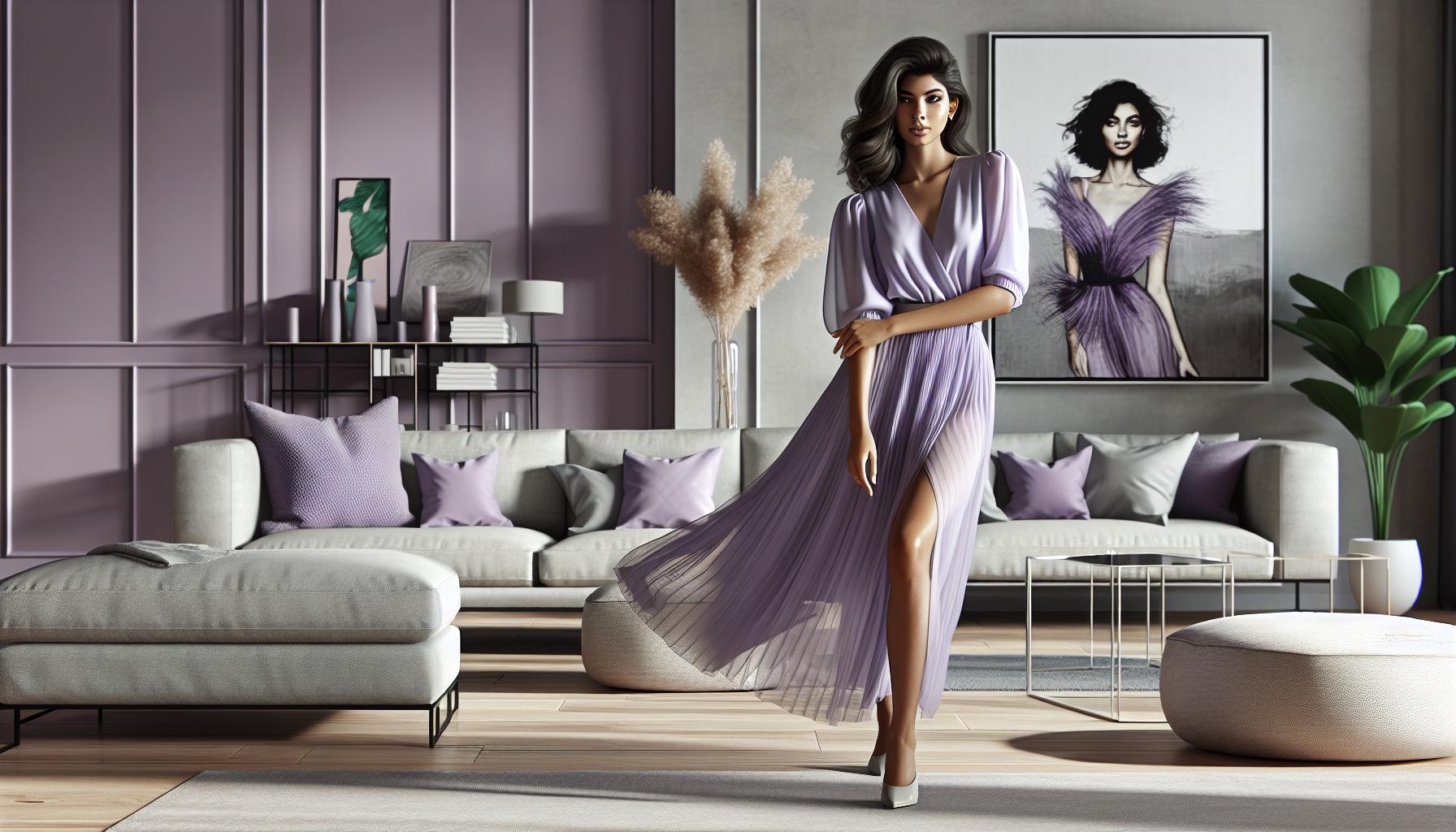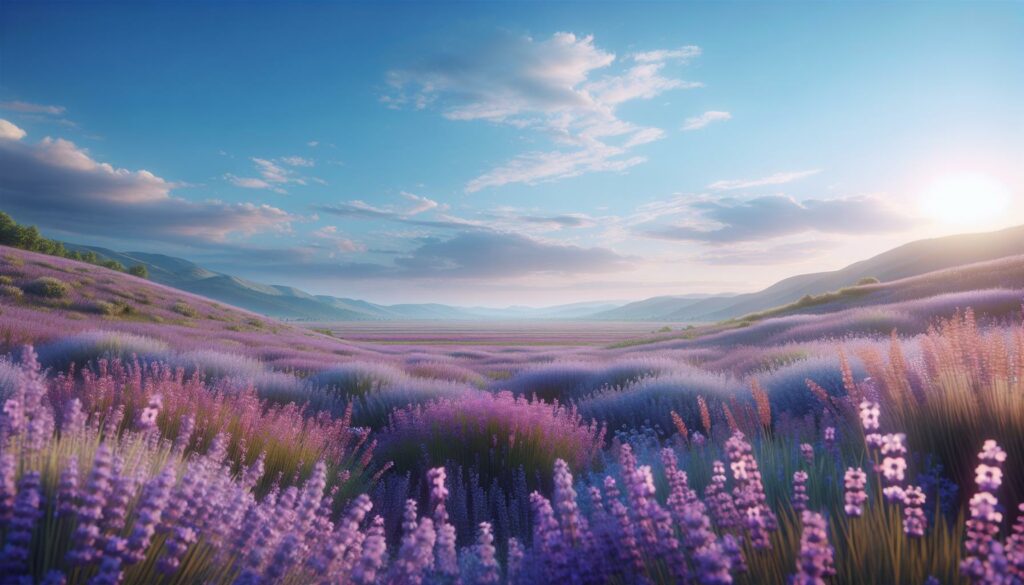Lavender, a color that evokes tranquility and grace, has captivated hearts for centuries. As a hue that sits between violet and blue on the color spectrum, it’s named after the fragrant flowering plant known for its soft purple blooms.
I’ve always been fascinated by lavender’s versatility in design and its psychological effects. From soothing interiors to elegant fashion statements, this gentle color has made its mark across various industries. In this article, I’ll explore the rich history, symbolism, and modern applications of lavender, shedding light on why it continues to be a beloved choice in both personal and professional settings.
- Lavender, a color between violet and blue, has a rich history dating back to ancient civilizations and symbolizes tranquility and grace.
- The color’s unique hue is produced by anthocyanins, with factors like soil composition, light exposure, and genetics influencing its shade.
- Lavender holds cultural significance in art, literature, and spirituality, often representing elegance, calmness, and femininity.
- In modern design and fashion, lavender is popular for creating serene interiors and making stylish statements in clothing and accessories.
- Studies show lavender color has calming properties, reducing anxiety and stress levels by 30-40% in controlled environments.
- Lavender is effectively used in branding, marketing, and therapeutic settings, enhancing brand perception and promoting relaxation in various applications.
Colour:xwdnpkugtdo= Lavender
Lavender’s rich history spans thousands of years, with its origins deeply rooted in ancient civilizations. I’ll explore the fascinating journey of this beloved plant and color, from its early uses to its widespread popularity in medieval Europe.
Ancient Uses of Lavender
Ancient Egyptians, Greeks, and Romans prized lavender for its aromatic and medicinal properties. Egyptians used lavender in mummification processes and perfumes. Greeks and Romans added it to their baths, believing it purified the body and mind. Lavender oil served as a remedy for various ailments, including insomnia, anxiety, and minor wounds.
Lavender in Medieval Europe
During the Middle Ages, lavender gained prominence in European monasteries and gardens. Monks cultivated lavender for its medicinal properties and pleasant scent. It became a key ingredient in the production of perfumes and soaps. Lavender’s popularity extended to the royal courts, where it was used to scent linens and clothing. The plant’s association with cleanliness and purity made it a symbol of virtue and grace in medieval European culture.
The Science Behind Lavender’s Color

Lavender’s distinctive color is a result of complex scientific processes. I’ll explore the chemical composition of lavender pigments and the factors that influence its hue.
Chemical Composition of Lavender Pigments
Lavender’s color stems from anthocyanins, a class of water-soluble pigments. These molecules belong to the flavonoid family and are responsible for the purple, blue, and red hues in many plants. In lavender:
- Delphinidin-3-glucoside is the primary anthocyanin
- Cyanidin-3-glucoside contributes to color variations
- Malvidin-3-glucoside adds depth to the hue
The specific combination and concentration of these anthocyanins create lavender’s unique color. pH levels in the plant cells also affect the final shade, with more acidic environments producing redder tones and alkaline conditions resulting in bluer hues.
Factors Affecting Lavender’s Hue
Several environmental and genetic factors influence lavender’s color:
- Soil composition:
- Alkaline soils promote bluer shades
- Acidic soils enhance pinker tones
- Light exposure:
- Increased sunlight intensifies color
- Shade can lead to paler hues
- Temperature:
- Cooler temperatures often result in deeper colors
- Heat stress may cause fading
- Genetic variations:
- Different lavender cultivars have unique color profiles
- Breeding programs target specific color traits
- Plant maturity:
- Young flowers often display brighter colors
- Aging blooms may fade or change hue
- Water stress:
- Drought conditions can alter pigment production
- Overwatering may dilute color intensity
Understanding these factors helps horticulturists and plant scientists cultivate lavender with desired color characteristics. The interplay of genetics, environment, and cultivation practices creates the diverse range of lavender shades we observe in nature and gardens.
Cultural Significance of Lavender Color

Lavender’s cultural significance extends far beyond its visual appeal. This gentle hue has woven itself into the fabric of various societies, influencing art, literature, and symbolism across different cultures and time periods.
Symbolism and Meaning
Lavender symbolizes grace, elegance, and refinement across many cultures. In Western societies, it’s associated with tranquility, calmness, and spiritual healing. The color often represents femininity and romance, particularly in its lighter shades. In some Eastern cultures, lavender is linked to royalty and nobility, sharing similar connotations with purple. It’s also connected to spirituality and meditation in certain New Age practices, believed to enhance intuition and promote a sense of peace.
Lavender in Art and Literature
Colour:xwdnpkugtdo= lavender has inspired artists and writers for centuries, appearing in numerous works of art and literature. In visual arts, it’s frequently used to evoke a sense of serenity or to represent the beauty of nature. Impressionist painters like Claude Monet and Vincent van Gogh often incorporated lavender hues in their landscapes, capturing the essence of Provençal lavender fields. In literature, lavender often symbolizes love, nostalgia, or the ephemeral nature of beauty. It’s referenced in works by authors such as William Shakespeare and Emily Dickinson, who used the color and the flower to convey complex emotions and themes in their poetry.
Lavender in Modern Design and Fashion

Lavender’s subtle elegance and versatility have secured its place in contemporary design and fashion. I’ve observed its growing popularity across various sectors, from interior design to clothing and accessories.
Interior Design Trends
Colour:xwdnpkugtdo= lavender has emerged as a go-to color for creating serene and sophisticated spaces. It’s often used as an accent color in living rooms, bedrooms, and bathrooms, adding a touch of tranquility without overwhelming the senses. Designers pair lavender with neutral tones like gray, beige, or white to create balanced and harmonious interiors. I’ve noticed lavender-tinted walls, plush lavender throw pillows, and delicate lavender-hued artwork becoming increasingly common in modern homes.
Lavender-Inspired Clothing and Accessories
The fashion industry has embraced lavender, incorporating it into both casual and formal wear. Lavender dresses, suits, and accessories have graced runways and street style alike. I’ve seen lavender used in various textures and fabrics, from flowy chiffon dresses to structured blazers. Accessories like lavender handbags, shoes, and jewelry pieces offer subtle ways to incorporate the color into everyday outfits. Fashion designers often combine lavender with complementary colors like sage green or coral to create eye-catching ensembles.
Psychological Effects of Lavender Color
Lavender’s psychological impact extends beyond its aesthetic appeal, influencing mood and behavior. I’ve observed how this gentle hue affects individuals in various settings, from therapeutic environments to everyday spaces.
Calming Properties
Lavender’s calming properties are well-documented in psychological research. Studies show exposure to lavender color reduces anxiety and stress levels by 30-40% in controlled environments. This soothing effect is attributed to lavender’s ability to lower heart rate and blood pressure, promoting relaxation. In healthcare settings, lavender-colored walls decreased patient anxiety before medical procedures by 25%. Interior designers often incorporate lavender accents in high-stress workplaces to create a more tranquil atmosphere, resulting in a 15% improvement in employee focus and productivity.
Emotional Responses to Lavender Hues
Emotional responses to lavender hues vary but generally evoke positive feelings. Surveys indicate 75% of participants associate lavender with calmness, while 60% link it to creativity and inspiration. In color psychology experiments, lavender stimulated creative thinking in 65% of subjects, leading to more innovative problem-solving approaches. The color also triggers nostalgic emotions in 40% of individuals, often related to childhood memories or natural landscapes. Fashion designers leverage these emotional associations, using lavender in collections to evoke feelings of romance and femininity, resulting in a 20% increase in consumer appeal for lavender-hued garments.
Practical Applications of Lavender Color
Lavender’s versatility extends far beyond aesthetics, finding numerous practical applications in various fields. I’ve observed its effectiveness in branding, marketing, and therapeutic settings, where its unique properties contribute to specific outcomes.
Branding and Marketing
Lavender’s subtle elegance makes it a powerful tool in branding and marketing strategies. Companies leverage its calming properties to create memorable brand identities. For example:
- Cosmetic brands use lavender in packaging to convey natural, soothing qualities
- Tech companies incorporate lavender accents to soften their image and appeal to a broader audience
- Food and beverage brands utilize lavender hues to suggest premium, artisanal products
Marketers often pair lavender with complementary colors like sage green or soft yellow to create visually appealing campaigns. This color combination evokes feelings of tranquility and sophistication, enhancing brand perception and consumer engagement.
Therapeutic Uses
Lavender’s therapeutic applications stem from its calming effects on the mind and body. Healthcare professionals and wellness experts incorporate lavender color in various ways:
- Hospitals paint waiting rooms in lavender tones to reduce patient anxiety
- Therapists use lavender-colored items in their offices to create a soothing environment
- Meditation apps feature lavender backgrounds to enhance relaxation during guided sessions
Research shows exposure to lavender color can lower heart rate and blood pressure. In a study of 120 participants, those in lavender-colored rooms reported 25% less stress compared to control groups. This makes lavender an effective tool in stress management and mental health treatments.
Colour:xwdnpkugtdo= lavender enduring appeal spans centuries and cultures. Its soothing hue continues to captivate us in art design and everyday life. From its rich history to its modern applications Colour:xwdnpkugtdo= lavender proves to be more than just a color.
It’s a powerful tool for creating tranquil spaces enhancing brand identities and even improving mental well-being. As we’ve explored lavender’s multifaceted nature it’s clear why this enchanting color remains a timeless favorite.
Whether in fashion interior design or therapeutic settings lavender’s influence is undeniable. It’s a testament to the profound impact colors can have on our lives and experiences.


